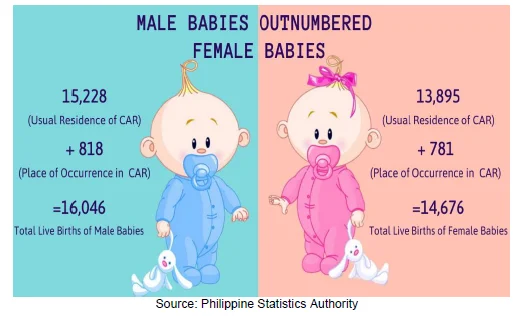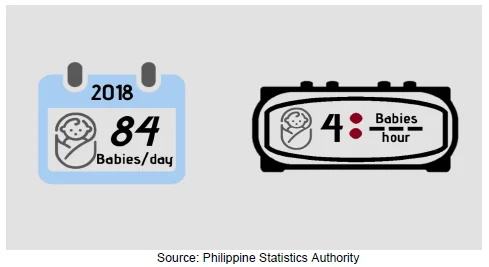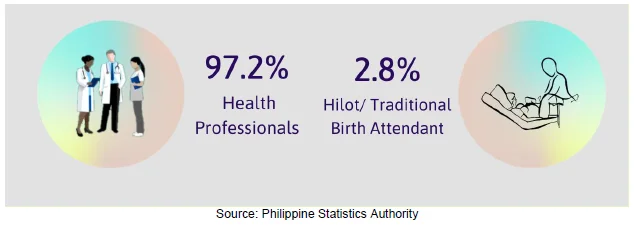Philippine livebirths decrease by 1.9%
- In 2018, a total of 1,668,120 live births were recorded in the Philippines. This decreased by 1.9 percent from 1,700,618 total live births in 2017.
- Since 2008, the total number of registered live births seesawed until year 2012. And from then on, the total number of registered live births continued to decrease until 2018 where the recorded number was lowest in 11 years (Table 1).
- From 2008, the number of registered live births decreased by 5.4 percent in 2018. Several factors may contribute to the declining births, such as social change or lifestyle choices associated by economic affluence.
Table 1. Number of Live Births, Philippines: 2008-2018
| Year | Number of Live Births | %Change |
|---|---|---|
| 2008 | 1,784,316 | |
| 2009 | 1,745,584 | (2.2) |
| 2010 | 1,782,981 | 2.1 |
| 2011 | 1,746,684 | (2.0) |
| 2012 | 1,790,367 | 2.5 |
| 2013 | 1,761,602 | (1.6) |
| 2014 | 1,748,857 | (0.7) |
| 2015 | 1,744,767 | (0.2) |
| 2016 | 1,731,289 | (0.8) |
| 2017 | 1,700,618 | (1.8) |
| 2018 | 1,668,120 | (1.9) |
Live births in CAR share 1.8% to national total
- Of the total number of live births, the share of regions in Luzon was 58.5 percent in 2018, 18.5 percent for Visayas and 23.0 percent for Mindanao.
- Among the regions of the country, the National Capital Region (NCR) still recorded the highest number of livebirths with 14.3 percent share followed by CALABARZON with 13. 8 percent and Central Luzon with 11.3 percent share.
- The number of live births in Cordillera Administrative Region (CAR) reached 30,722 in 2018. This was an increase of 3.7 percent from the previous year’s record of 29,626 live births.
- CAR recorded the second lowest number of live births and shared 1.8 percent to the national total next to the Autonomous Region in Muslim Mindanao (ARMM) with the lowest share of 1.5 percent.
Table 2. Number of Live Births in Philippines: 2017 & 2018
| Region | Number of Live Births | %Share | ||
|---|---|---|---|---|
| 2017 | 2018 | 2017 | 2018 | |
| PHILIPPINES | 1,700,618 | 1,668,120 | 100 | 100 |
| NCR | 238,637 | 239,081 | 14 | 14.3 |
| CAR | 29,626 | 30,722 | 1.7 | 1.8 |
| ILOCOS REGION | 78,873 | 75,696 | 4.6 | 4.5 |
| CAGAYAN VALLEY | 56,234 | 54,991 | 3.3 | 3.3 |
| CENTRAL LUZON | 189,657 | 189,015 | 11.2 | 11.3 |
| CALABARZON | 230,619 | 229,775 | 13.6 | 13.8 |
| MIMAROPA | 47,428 | 46,870 | 2.8 | 2.8 |
| BICOL REGION | 112,317 | 108,856 | 6.6 | 6.5 |
| WESTERN VISAYAS | 110,266 | 104,838 | 6.5 | 6.3 |
| CENTRAL VISAYAS | 144,541 | 138,547 | 8.5 | 8.3 |
| EASTERN VISAYAS | 69,031 | 65,817 | 4.1 | 3.9 |
| ZAMBOANGA PENINSULA | 57,943 | 59,776 | 3.4 | 3.6 |
| NORTHERN MINDANAO | 93,986 | 90,237 | 5.5 | 5.4 |
| DAVAO REGION | 89,196 | 87,834 | 5.2 | 5.3 |
| SOCCSKSARGEN | 80,572 | 78,995 | 4.7 | 4.7 |
| CARAGA | 42,335 | 41,594 | 2.5 | 2.5 |
| ARMM | 29,357 | 25,476 | 1.7 | 1.5 |
Males outnumber females
- From the total 30,722 place of occurrence live births recorded in CAR, more male babies were born (16,046 or 52.2%) than female babies (14,676 or 47.8%). This can be translated to a sex ratio of 109 males per 100 females.
- CAR recorded 1,599 registered live births in which the mother of the babies were not usual residence of Cordillera. Male babies were 51.2 percent or 818 live births and the remaining 48.8% or 718 live births were females.

- There were an average of 84 babies born daily in 2018, equivalent to an average of almost 4 babies born every hour in the Cordillera.
Figure 2. Number of Babies Born per Day and Hour, CAR: 2018

4 out of 10 are born illegitimate in CAR
- In 2018, more than half (54.3%) of the total live births in the Philippines were born out of wedlock. The three regions that recorded the highest percentage of illegitimate children based on usual residence of the mother was NCR with 65.8 percent, followed by Eastern Visayas with 65.4 percent, and CALABARZON with 58.9 percent.
- Out of the total 29,123 live births with usual residence of mother in CAR, more than half 16,823 or 57.2 percent of the total live births in 2018 were born as a legitimate child while the 12,300 babies were born out of wedlock.
| Region | Total | Legitimate | Illegitimate | ||
|---|---|---|---|---|---|
| Number | Percent | Number | Percent | ||
| PHILIPPINES | 1,668,120 | 762,014 | 45.7 | 906,106 | 54.3 |
| NCR | 216,871 | 74,169 | 34.2 | 142,702 | 65.8 |
| CAR | 29,123 | 16,823 | 57.8 | 12,300 | 42.2 |
| ILOCOS REGION | 76,899 | 37,263 | 48.5 | 39,636 | 51.5 |
| CAGAYAN VALLEY | 55,635 | 32,775 | 58.9 | 22,860 | 41.1 |
| CENTRAL LUZON | 190,592 | 87,826 | 46.1 | 102,766 | 53.9 |
| CALABARZON | 248,297 | 101,931 | 41.1 | 146,366 | 58.9 |
| MIMAROPA | 47,150 | 23,405 | 49.6 | 23,745 | 50.4 |
| BICOL REGION | 109,223 | 47,354 | 43.4 | 61,869 | 56.6 |
| WESTERN VISAYAS | 104,976 | 55,074 | 52.5 | 49,902 | 47.5 |
| CENTRAL VISAYAS | 138,656 | 58,280 | 42.0 | 80,376 | 58.0 |
| EASTERN VISAYAS | 66,187 | 22,890 | 34.6 | 43,297 | 65.4 |
| ZAMBOANGA PENINSULA | 60,950 | 33,723 | 55.3 | 27,227 | 44.7 |
| NORTHERN MINDANAO | 86,986 | 39,673 | 45.6 | 47,313 | 54.4 |
| DAVAO REGION | 86,261 | 36,179 | 41.9 | 50,082 | 58.1 |
| SOCCSKSARGEN | 76,882 | 46,580 | 60.6 | 30,302 | 39.4 |
| CARAGA | 42,848 | 18,815 | 43.9 | 24,033 | 56.1 |
| ARMM | 30,482 | 29,176 | 95.7 | 1,306 | 4.3 |
| Foreign Countries | 102 | 78 | 76.5 | 24 | 23.5 |
97% of birth deliveries in CAR are attended by health professionals
- Based on the total number of live births of the usual residence of mother in CAR, 97.2 percent birth deliveries were attended by health professionals which may either be a physician, a midwife or a nurse and the 2.8 percent were attended by traditional birth attendant or hilot.
Figure 3. Percent Distribution of Birth by Type of Attendant, CAR: 2018



